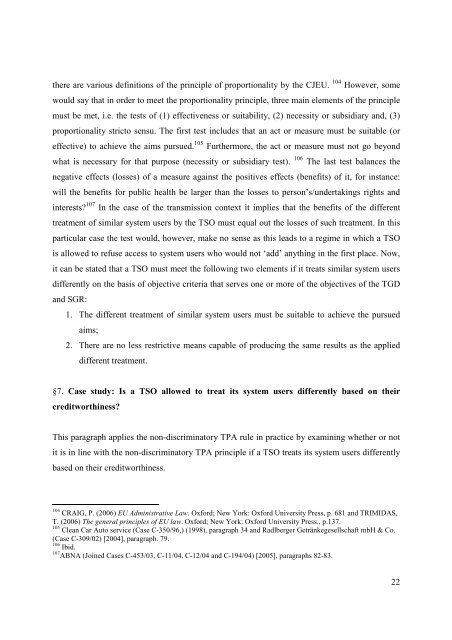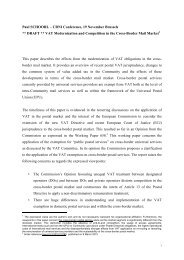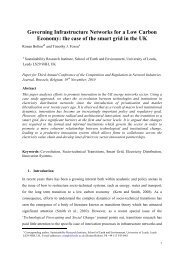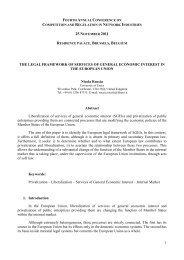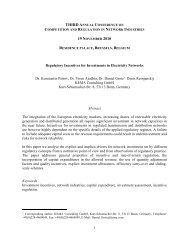Non-discriminatory Third Party Access to the Gas Transmission ...
Non-discriminatory Third Party Access to the Gas Transmission ...
Non-discriminatory Third Party Access to the Gas Transmission ...
Create successful ePaper yourself
Turn your PDF publications into a flip-book with our unique Google optimized e-Paper software.
<strong>the</strong>re are various definitions of <strong>the</strong> principle of proportionality by <strong>the</strong> CJEU. 104 However, some<br />
would say that in order <strong>to</strong> meet <strong>the</strong> proportionality principle, three main elements of <strong>the</strong> principle<br />
must be met, i.e. <strong>the</strong> tests of (1) effectiveness or suitability, (2) necessity or subsidiary and, (3)<br />
proportionality stric<strong>to</strong> sensu. The first test includes that an act or measure must be suitable (or<br />
effective) <strong>to</strong> achieve <strong>the</strong> aims pursued. 105 Fur<strong>the</strong>rmore, <strong>the</strong> act or measure must not go beyond<br />
what is necessary for that purpose (necessity or subsidiary test). 106 The last test balances <strong>the</strong><br />
negative effects (losses) of a measure against <strong>the</strong> positives effects (benefits) of it, for instance:<br />
will <strong>the</strong> benefits for public health be larger than <strong>the</strong> losses <strong>to</strong> person’s/undertakings rights and<br />
interests 107 In <strong>the</strong> case of <strong>the</strong> transmission context it implies that <strong>the</strong> benefits of <strong>the</strong> different<br />
treatment of similar system users by <strong>the</strong> TSO must equal out <strong>the</strong> losses of such treatment. In this<br />
particular case <strong>the</strong> test would, however, make no sense as this leads <strong>to</strong> a regime in which a TSO<br />
is allowed <strong>to</strong> refuse access <strong>to</strong> system users who would not ‘add’ anything in <strong>the</strong> first place. Now,<br />
it can be stated that a TSO must meet <strong>the</strong> following two elements if it treats similar system users<br />
differently on <strong>the</strong> basis of objective criteria that serves one or more of <strong>the</strong> objectives of <strong>the</strong> TGD<br />
and SGR:<br />
1. The different treatment of similar system users must be suitable <strong>to</strong> achieve <strong>the</strong> pursued<br />
aims;<br />
2. There are no less restrictive means capable of producing <strong>the</strong> same results as <strong>the</strong> applied<br />
different treatment.<br />
§7. Case study: Is a TSO allowed <strong>to</strong> treat its system users differently based on <strong>the</strong>ir<br />
creditworthiness<br />
This paragraph applies <strong>the</strong> non-<strong>discrimina<strong>to</strong>ry</strong> TPA rule in practice by examining whe<strong>the</strong>r or not<br />
it is in line with <strong>the</strong> non-<strong>discrimina<strong>to</strong>ry</strong> TPA principle if a TSO treats its system users differently<br />
based on <strong>the</strong>ir creditworthiness.<br />
104 CRAIG, P. (2006) EU Administrative Law. Oxford; New York: Oxford University Press, p. 681 and TRIMIDAS,<br />
T. (2006) The general principles of EU law. Oxford; New York: Oxford University Press., p.137.<br />
105 Clean Car Au<strong>to</strong> service (Case C-350/96,) (1998), paragraph 34 and Radlberger Getränkegesellschaft mbH & Co.<br />
(Case C-309/02) [2004], paragraph. 79.<br />
106 Ibid.<br />
107 ABNA (Joined Cases C-453/03, C-11/04, C-12/04 and C-194/04) [2005], paragraphs 82-83.<br />
22


